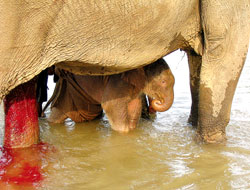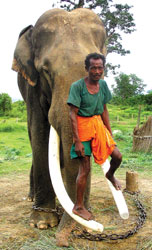|
|
| Bishnu Chaudhary with his elephant Erawat Gaj. |
In the past, the Tharu people of the tarai had a monopoly on the capture, training and care of elephants, which they managed on behalf of the Shahs and the Ranas, who utilised their captive elephant resources to engage in lavish hunts.
In the 19th century, Nepal even pioneered its own method of hunting: the 'ring', which entailed as many as 300 elephants encircling tracked prey such as tiger and rhino. Once trapped within the ring, the Maharaja and any visiting dignitaries would enter upon elephant back, from where they could then shoot the prey. During this era, Nepal even hosted the British monarchy, including King George V in 1908 and the future Queen Elizabeth II in 1950.
Although the days of hunting are now long gone, the traditional elephant handling skills that were fostered in that time live on. In Chitwan today, the Department of National Parks and Wildlife Conservation (DNPWC), the King Mahendra Trust for Nature Conservation (KMTNC), and safari resorts and hotels all employ elephant handlers.
 |
| Laxmi Kali, having just given birth to a male calf, which we nicknamed 'Mangal Prasad' as he was born on Tuesday, the day of Mars and Ganesh, and hence the most auspicious day for an elephant to be born. Elephants don't receive their official names until they are a year old. |
During 2003 and 2004 I lived with, and learnt from the elephant handlers (or hattisare) of the Khorsor Elephant Breeding Centre in Chitwan. My friend and colleague Mark Dugas also joined me to shoot a documentary film called Servants of Ganesh (see http://www.oneworldfilms.com).
Our film documents the training of a juvenile elephant called Paras Gaj and the experience of his trainer. Servants of Ganesh reveals the traditional prohibitions the trainer must adhere to, the rituals that must be performed to ensure success, as well as the dedication and respect of all the handlers for this animal, which is both a life companion and the sacred embodiment of the Hindu elephant-headed god Ganesh.
 |
| Cutting Narayani Kali's toenails. A perfect illustration of the intimate care the elephants receive from their handlers. |
Despite a lack of resources, Nepal has every reason to be proud of its elephant stables and the professionalism of its handlers. Indeed, perhaps there are even lessons for others. I was privileged to witness healthy, happy elephants with regular access to their natural jungle habitat, and to meet handlers, who although poor, were the skilful and committed beneficiaries of an unbroken tradition of apprenticeship. I remain indebted to their hospitality and am now compelled to champion the cause of Nepali captive elephant management.
Piers Locke is with the Department of Anthropology at the University of Kent in
the UK



